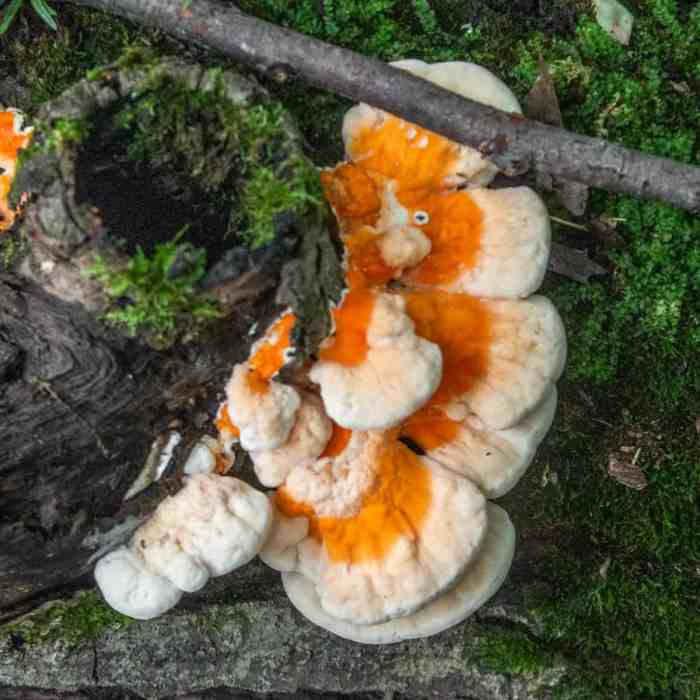
Discover the enticing world of chicken of the woods, a mushroom with a captivating flavor and remarkable versatility. From sautéing to grilling, this culinary gem offers endless possibilities to tantalize your taste buds. Let’s dive into the delectable depths of chicken of the woods recipe, exploring its nutritional value, culinary applications, and foraging tips.
Culinary Features: Chicken Of The Woods Recipe
Chicken of the woods is a culinary delight, prized for its unique taste and texture. Its flavor is often described as reminiscent of chicken, with a slightly nutty and earthy undertone. The texture is firm and meaty, making it a satisfying addition to various dishes.
The flavor and texture of chicken of the woods can vary depending on its age and the cooking method employed. Younger mushrooms tend to have a milder flavor and a more tender texture, while older mushrooms may develop a more intense flavor and a slightly tougher texture.
Sensory Profile
- Aroma:Earthy, nutty, with a hint of sweetness
- Mouthfeel:Firm, meaty, with a slight crunch
- Flavor:Chicken-like, nutty, earthy
- Aftertaste:Savory, slightly sweet, with a lingering earthiness
Versatile Preparations

Chicken of the woods can be prepared in various ways, offering a range of flavors and textures. From sautéing to grilling, each method enhances the mushroom’s unique characteristics.
Sautéing
Sautéing is a quick and easy way to cook chicken of the woods. Simply heat some oil in a pan and add the mushrooms. Cook until golden brown and tender, about 5-7 minutes. This method preserves the mushroom’s delicate flavor and texture.
Roasting
Roasting brings out the earthy notes of chicken of the woods. Preheat your oven to 400°F (200°C) and toss the mushrooms with olive oil, salt, and pepper. Roast for 20-25 minutes, or until tender and slightly browned.
Grilling
Grilling gives chicken of the woods a smoky flavor. Preheat your grill to medium-high heat and grill the mushrooms for 5-7 minutes per side, or until tender. This method imparts a slightly charred exterior while keeping the interior moist.
Frying
Frying chicken of the woods creates a crispy, golden-brown exterior. Dip the mushrooms in a batter of your choice and fry in hot oil until golden brown. This method is ideal for appetizers or as a side dish.
Tips for Preserving Flavor and Texture:
- Clean the mushrooms thoroughly before cooking to remove any dirt or debris.
- Use high heat to quickly cook the mushrooms and prevent them from becoming rubbery.
- Don’t overcook the mushrooms, as they can become tough and lose their flavor.
- Season the mushrooms with salt and pepper to enhance their natural flavors.
- Add herbs and spices to the cooking oil for extra flavor.
Nutritional Value

Chicken of the woods is a nutritional powerhouse, offering an impressive array of vitamins, minerals, and antioxidants. It’s an excellent source of protein, providing around 10 grams per 100 grams. This makes it a valuable plant-based protein source for vegetarians and vegans.
In addition to its high protein content, chicken of the woods is also a good source of fiber. Fiber helps promote digestive health and can aid in weight management. It also contains an array of vitamins and minerals, including vitamin C, potassium, and iron.
Comparison to Other Mushrooms, Chicken of the woods recipe
Compared to other types of mushrooms, chicken of the woods has a relatively high nutritional value. It contains more protein and fiber than many other popular edible mushrooms, such as white button mushrooms or oyster mushrooms.
Potential Health Concerns
While chicken of the woods is generally considered safe to consume, there are some potential health concerns to be aware of. Some people may experience gastrointestinal upset after eating chicken of the woods, especially if they are not used to eating large amounts of fiber.
Additionally, chicken of the woods can accumulate heavy metals, such as lead and cadmium, so it’s important to avoid harvesting it from contaminated areas.
Have you ever tried the chicken of the woods recipe ? It’s a delicious and unique way to enjoy this wild mushroom. The texture is similar to chicken, and the flavor is earthy and slightly sweet. You can sauté it, fry it, or even grill it.
If you’re looking for a vegetarian or vegan alternative to chicken, this is definitely worth trying.
Culinary Applications

Chicken of the woods is a versatile culinary ingredient that can be incorporated into various dishes, adding a unique and flavorful touch to soups, stews, salads, and main courses. Its meaty texture and delicate flavor make it a popular choice among mushroom enthusiasts and chefs alike.
Culinary Versatility
Chicken of the woods’ versatility extends beyond its use as a meat substitute. It can be grilled, roasted, sautéed, or fried, showcasing its adaptability to different cooking methods. The mushroom’s firm texture holds up well in stir-fries and casseroles, while its delicate flavor complements a wide range of seasonings and sauces.
Culinary Traditions
Chicken of the woods has a rich culinary history, featuring prominently in various cuisines worldwide. In North America, it is a popular ingredient in soups and stews, while in Europe, it is often used in sautéed dishes and risottos. In Asia, chicken of the woods is a prized ingredient in stir-fries and curries.
Foraging and Identification

Chicken of the woods is a versatile and flavorful mushroom that can be found in forests worldwide. It grows on the trunks and branches of deciduous trees, particularly oak, beech, and maple. The mushroom is typically found in clusters and has a bright orange or yellow color.
It has a meaty texture and a slightly fruity flavor.
To identify chicken of the woods, look for a mushroom with a bright orange or yellow color and a velvety texture. The mushroom should be firm to the touch and have a slightly fruity smell. Avoid mushrooms that are slimy or have a foul odor.
Another great chicken of the woods recipe is to make a soup or stew. The mushrooms add a rich, earthy flavor to the broth, and they’re a great source of fiber and nutrients. You can also add other vegetables, such as carrots, celery, and onions, to the soup.
This is a hearty and flavorful meal that’s perfect for a cold winter night.
Harvesting
When harvesting chicken of the woods, it is important to use a sharp knife to cut the mushroom from the tree. Leave the base of the mushroom intact to prevent damage to the tree. Chicken of the woods can be stored in the refrigerator for up to a week.
Responsible Foraging
When foraging for chicken of the woods, it is important to be responsible and respectful of the environment. Only harvest mushrooms that you are certain are edible. Do not over-harvest mushrooms, and leave some behind for other foragers and wildlife.
It is also important to avoid damaging the trees that the mushrooms grow on.
Risks of Misidentification
There are several poisonous mushrooms that resemble chicken of the woods. It is important to be able to identify these mushrooms to avoid accidental poisoning. If you are not sure whether a mushroom is edible, it is best to err on the side of caution and leave it alone.
Final Conclusion
Whether you’re a seasoned forager or a culinary novice, chicken of the woods recipe is an adventure waiting to be savored. Embrace its unique taste, experiment with various cooking techniques, and enjoy its nutritional benefits. So, gather your foraging gear or head to the farmers’ market, and let the magic of chicken of the woods transform your culinary creations.
FAQ Compilation
What are the key flavor notes of chicken of the woods?
Chicken of the woods boasts a savory, slightly sweet flavor with hints of chicken and seafood.
How do I ensure I’m harvesting chicken of the woods safely?
Only harvest from reputable sources and consult with experienced foragers to accurately identify the mushroom.
What are some creative ways to use chicken of the woods in cooking?
Try it in soups, stews, stir-fries, or as a meat substitute in vegetarian dishes.